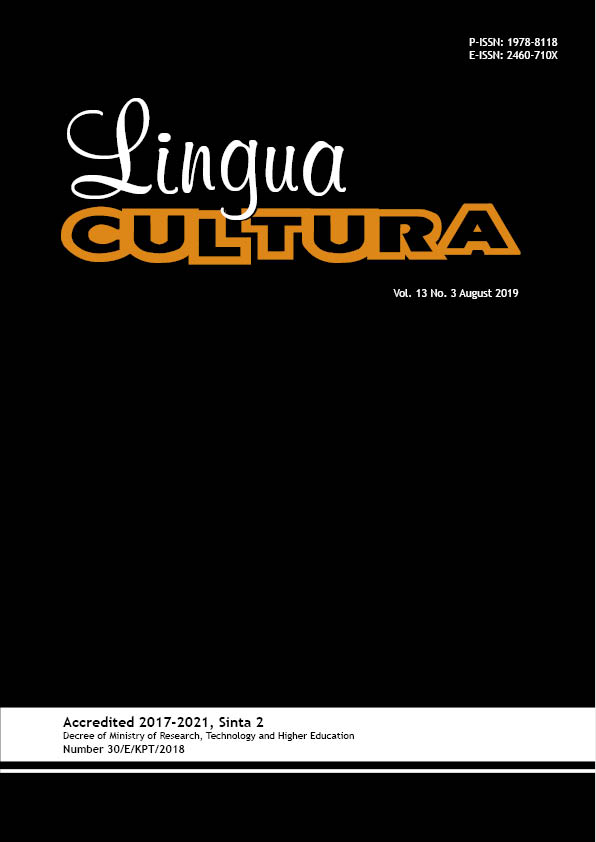The Representation of Patriarchy in Indonesian Children Folk Tales from Sumatra Island
DOI:
https://doi.org/10.21512/lc.v13i3.5646Keywords:
patriarchy representation, patriarchal values, children folk tales, semioticAbstract
This research aimed to discuss the topic of patriarchal research because it still existed in several countries in the world, especially Asia and more specifically, in Indonesia. This research was conducted to reveal how patriarchal values were reflected in Indonesian children’s folk tales from Sumatra Island. This research used a sociological approach to literature and used semiotic theory to analyze the data obtained. The researcher chose to use a qualitative descriptive method so that the analysis process could be described completely. The main data used in this research are several children’s folk tales originating from Sumatra Island, namely Province of North Sumatra (“Di Balik Derita Si Boru Tombagaâ€, “Bohong Merinangâ€, and “Si Kodok Kata Malem, Baik Budi Penawan Hatiâ€), South Sumatra (“Langkuse dan Putri Rambut Putihâ€), and Jambi (“Legenda Bukit Perakâ€). This research finds that patriarchal values are represented in how women are associated with domestic works, women are considered as the subordinates and inferiors, as well as showing their dependence on men.
References
Adipoetra, F. G. (2016). Representasi patriarki dalam film “Batasâ€. Jurnal E-Komunikasi, 4(1), 1-11.
Aritonang, B. (2016). Di balik derita si Boru Tombaga. Jakarta: Badan Pengembangan dan Pembinaan Bahasa.
Asri, Y. (2018). Women’s rejection toward patriarchy culture: A feminism study in selected Indonesian novels. Atlantis Press: Advances in Social Science, Education and Humanities Research (ASSEHR), 148, 200–205.
Bennet, T. (2015). Cultural studies and the culture concept. Cultural Studies, 29(4), 546-568. https://doi.org/https://doi.org/10.1080/09502386.2014.1000605.
Dutt, A. (2018). Locating patriarchy in violence against women in India: Social, legal, and alternative responses. PEOPLE: International Journal of Social Sciences, 4(2), 212-228. https://doi.org/10.20319/pijss.2018.42.212228.
Fathoni, R. S. (2017). Wawasan sejarah. Retrieved February 1, 2019, from http://wawasansejarah.com/dinamika-penghulu-indonesia/
Fitri, N., & Suparti, E. (2016). Analyzing the portrayal of patriarchal oppression towards the female characters in J. K. Rowling’s â€The Casual Vacancyâ€: A reflective post-feminist critics. CaLLs: Journal of Culture, Arts, Literature, and Linguistics, 2(1), 43-52. https://doi.org/http://dx.doi.org/10.30872/calls.v2i1.703.
Florence, N. (2016). Female role models in Bukusu folktales: Education at the mother’s hearth. International & Comparative Education, 3, 1-13. https://doi.org/https://doi.org/10.1080/2331186X.2016.1185238.
Manik, R. A. (2016). Legenda bukit perak. Jakarta: Badan Pengembangan dan Pembinaan Bahasa.
Masykuroh, Q. (2016). Physical and verbal violence in Indonesian folktales retold in children’s books. Kajian Linguistik dan Sastra, 1(1), 25–34. https://doi.org/10.23917/kls.v1i1.2475.
Nurhayati, S. (2019). Indonesian folktales: Feminism and the query of femaleness. Leksika: Jurnal Bahasa, Sastra, dan Pengajarannya, 13(1), 12–17. https://doi.org/10.30595/lks.v13i1.4073.
Rawat, P. S. (2014). Patriarchal beliefs, women’s empowerment, and general well-being. Vikalpa: The Journal for Decision Makers, 39(2), 43–55. https://doi.org/https://doi.org/10.1177/0256090920140206.
Rosida, I., & Rejeki, L. (2017). Woman in patriarchal culture: Gender discrimination and intersectionality portrayed in â€Bob Darling†by Carolyn Cooke. Insaniyat, Journal of Islam and Humanities, 1(2), 129–139.
Ruggles, S. (2015). Patriarchy, power, and pay: The transformation of American families. Demography, 52(6), 1797–1823. https://doi.org/10.1007/s13524-015-0440-z.
Sakinah, A. I., & Siti, D. H. (2017). Menyoroti budaya patriarki di Indonesia. SHARE: Social Work Journal, 7(1), 71-80. doi: https://doi.org/10.24198/share.v7i1.13820.
Sianturi, J. N. (2017). Makna anak laki-laki di masyarakat Batak Toba. Journal Online Mahasiswa Fakultas Ilmu Sosial dan Ilmu Politik Universitas Riau, 4(2), 1–14.
Suhadi. (2015). The portrait of women resistance towards patriarchy system in the movie of â€Dilema Ijab Kabulâ€. KOMUNITAS International Journal of Indonesian Society And Culture, 7(2), 259–270. https://doi.org/10.15294/komunitas.v7i2.3601.
Sulastri, H. (2016). Si kodok kata malem, baik budi penawan hati. Jakarta: Badan Pengembangan dan Pembinaan Bahasa.
Suliman, N. N. (2019). The intertwined relationship between power and patriarchy: Examples from resource extractive industries. Societies, 9(1), 1-11. https://doi.org/https://doi.org/10.3390/soc9010014.
Sullivan, E. V. (1984). A critical psychology: Interpretation of the personal world. New York: Springer.
Yakin, H. S. M., & Totua, A. (2014). The semiotic perspectives of Peirce and Saussure: A brief comparative study. Procedia - Social and Behavioral Sciences, 155, 4–8. https://doi.org/oi: 10.1016/j.sbspro.2014.10.247.
Zaimar, Y. S. (2017). Semiotic analysis of Valak and Lorraine in “The Conjuring 2†film. Scope: Journal of English Language Teaching, 1(2), 219-229. https://doi.org/http://dx.doi.org/10.30998/scope.v1i02.1112.
Downloads
Published
How to Cite
Issue
Section
License
Authors who publish with this journal agree to the following terms:
a. Authors retain copyright and grant the journal right of first publication with the work simultaneously licensed under a Creative Commons Attribution License - Share Alike that allows others to share the work with an acknowledgment of the work's authorship and initial publication in this journal.
b. Authors are able to enter into separate, additional contractual arrangements for the non-exclusive distribution of the journal's published version of the work (e.g., post it to an institutional repository or publish it in a book), with an acknowledgment of its initial publication in this journal.
c. Authors are permitted and encouraged to post their work online (e.g., in institutional repositories or on their website) prior to and during the submission process, as it can lead to productive exchanges, as well as earlier and greater citation of published work.
USER RIGHTS
All articles published Open Access will be immediately and permanently free for everyone to read and download. We are continuously working with our author communities to select the best choice of license options, currently being defined for this journal as follows: Creative Commons Attribution-Share Alike (CC BY-SA)


















